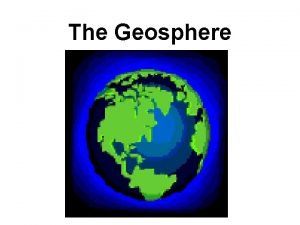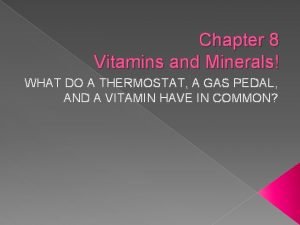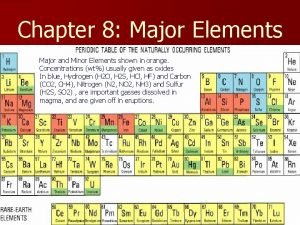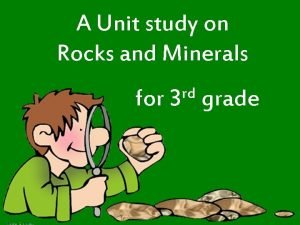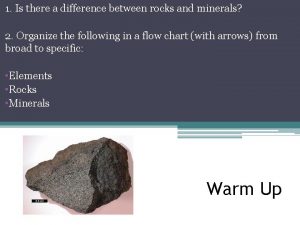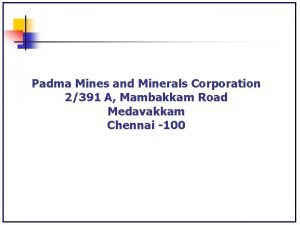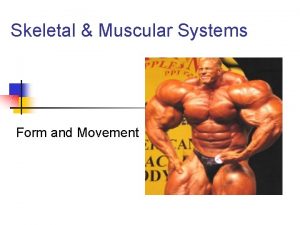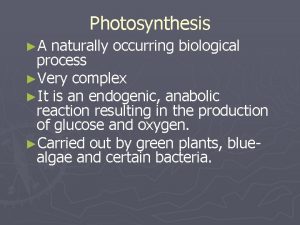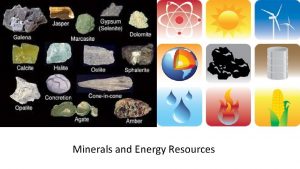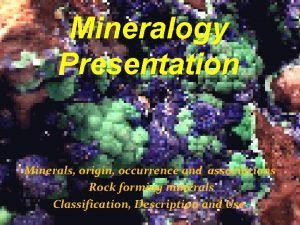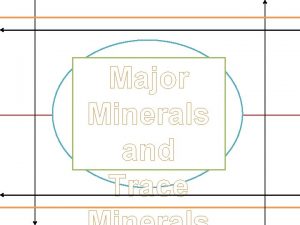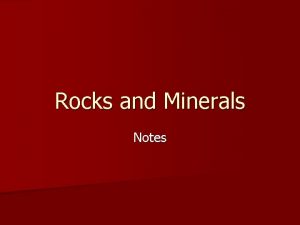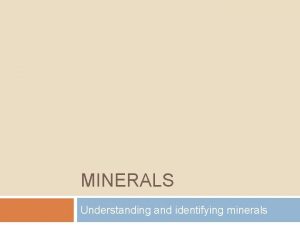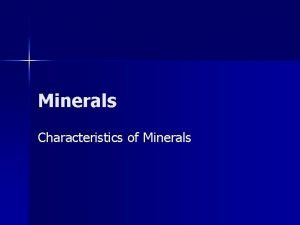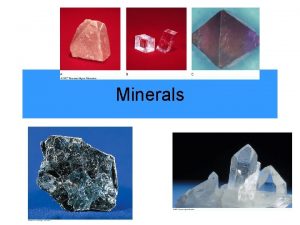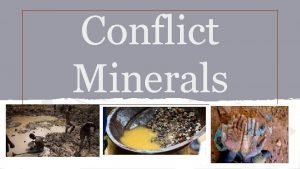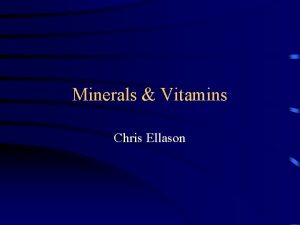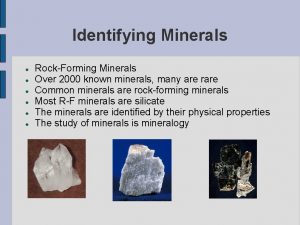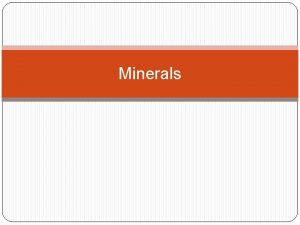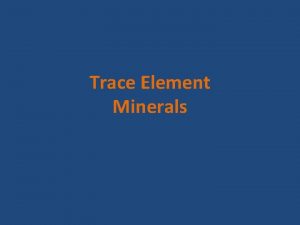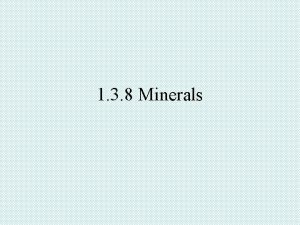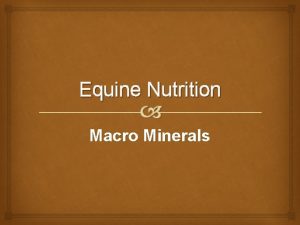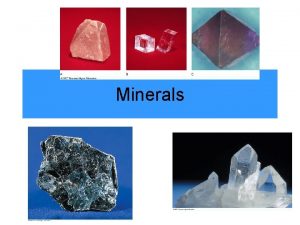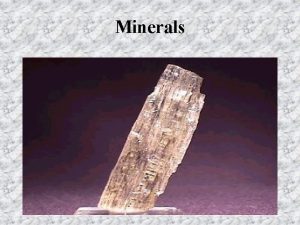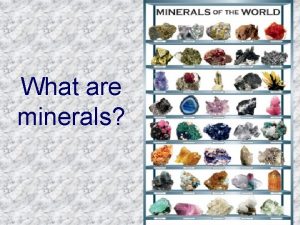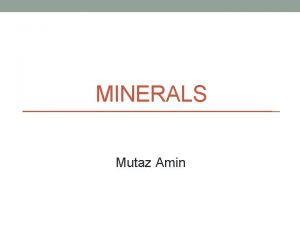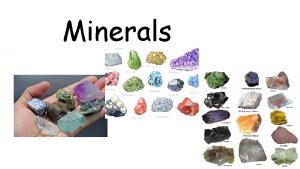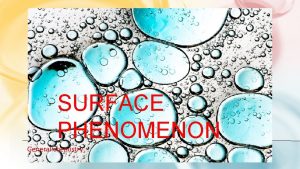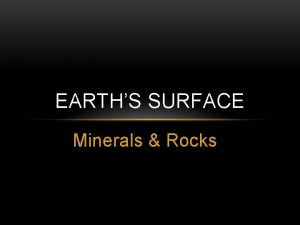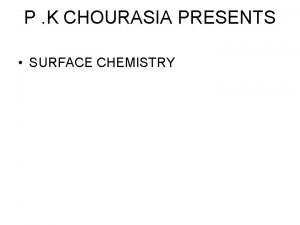Surface Chemistry SOIL MINERALS and SOIL STRUCTURE 1































- Slides: 31

Surface Chemistry SOIL MINERALS and SOIL STRUCTURE 1

Outline 1. 2. 3. 4. Clay Minerals Identification of Clay Minerals Specific Surface (Ss) Cation Exchange Capacity (CEC) 2

1. Clay Minerals 3

1. 1 Origin of Clay Minerals “The contact of rocks and water produces clays, either at or near the surface of the earth” (from Velde, 1995). Rock +Water Clay For example, The CO 2 gas can dissolve in water and form carbonic acid, which will become hydrogen ions H+ and bicarbonate ions, and make water slightly acidic. CO 2+H 2 O H 2 CO 3 H+ +HCO 3 The acidic water will react with the rock surfaces and tend to dissolve the K ion and silica from the feldspar. Finally, the feldspar is transformed into kaolinite. Feldspar + hydrogen ions+water clay (kaolinite) + cations, dissolved silica 2 KAl. Si 3 O 8+2 H+ +H 2 O Al 2 Si 2 O 5(OH)4 + 2 K+ +4 Si. O 2 • Note that the hydrogen ion displaces the cations. 4

1. 1 Origin of Clay Minerals (Cont. ) • The alternation of feldspar into kaolinite is very common in the decomposed granite. • The clay minerals are common in the filling materials of joints and faults (fault gouge, seam) in the rock mass. 5

1. 2 Basic Unit-Silica Tetrahedra 1 Si 4 O (Si 2 O 10)-4 Replace four Oxygen with hydroxyls or combine with positive union Tetrahedron Hexagonal hole Plural: Tetrahedra (Holtz and Kovacs, 1981) 6

1. 2 Basic Unit-Octahedral Sheet 1 Cation 6 O or OH Gibbsite sheet: Al 3+ Al 2(OH)6, 2/3 cationic spaces are filled One OH is surrounded by 2 Al: Dioctahedral sheet Different cations Brucite sheet: Mg 2+ Mg 3(OH)6, all cationic spaces are filled One OH is surrounded by 3 Mg: Trioctahedral sheet (Holtz and Kovacs, 1981) 7

1. 2 Basic Unit-Summary Mitchell, 1993 8

1. 3 Synthesis Mitchell, 1993 Noncrystall ine clay allophane 9

1. 4 1: 1 Minerals-Kaolinite Basal spacing is 7. 2 Å layer • Si 4 Al 4 O 10(OH)8. Platy shape • The bonding between layers are van der Waals forces and hydrogen bonds (strong bonding). • There is no interlayer swelling Trovey, 1971 ( from Mitchell, 1993) 17 m • Width: 0. 1~ 4 m, Thickness: 0. 05~2 m 10

1. 4 1: 1 Minerals-Halloysite • Si 4 Al 4 O 10(OH)8· 4 H 2 O • A single layer of water between unit layers. • The basal spacing is 10. 1 Å for hydrated halloysite and 7. 2 Å for dehydrated halloysite. • If the temperature is over 50 °C or the relative humidity is lower than 50%, the hydrated halloysite will lose its interlayer water (Irfan, 1966). Note that this process is irreversible and will affect the results of soil classifications (GSD and Atterberg limits) and compaction tests. Trovey, 1971 ( from Mitchell, 1993) 2 m • There is no interlayer swelling. • Tubular shape while it is hydrated. 11

1. 5 2: 1 Minerals-Montmorillonite • Si 8 Al 4 O 20(OH)4·n. H 2 O (Theoretical unsubstituted). Film-like shape. • There is extensive isomorphous substitution for silicon and aluminum by other cations, which results in charge deficiencies of clay particles. • n·H 2 O and cations exist between unit layers, and the basal spacing is from 9. 6 Å to (after swelling). n·H 2 O+cations • The interlayer bonding is by van der Waals forces and by cations which balance charge deficiencies (weak bonding). • There exists interlayer swelling, which is very important to engineering practice (expansive clay). • Width: 1 or 2 m, Thickness: 10 Å~1/100 width 5 m (Holtz and Kovacs, 1981) 12

1. 5 2: 1 Minerals-Illite (mica-like minerals) • Si 8(Al, Mg, Fe)4~6 O 20(OH)4·(K, H 2 O)2. Flaky shape. potassium • The basic structure is very similar to the mica, so it is sometimes referred to as hydrous mica. Illite is the chief constituent in many shales. K • Some of the Si 4+ in the tetrahedral sheet are replaced by the Al 3+, and some of the Al 3+ in the octahedral sheet are substituted by the Mg 2+ or Fe 3+. Those are the origins of charge deficiencies. • The charge deficiency is balanced by the potassium ion between layers. Note that the potassium atom can exactly fit into the hexagonal hole in the tetrahedral sheet and form a strong interlayer bonding. • The basal spacing is fixed at 10 Å in the presence of polar liquids (no interlayer swelling). 7. 5 m Trovey, 1971 ( from Mitchell, 1993) • Width: 0. 1~ several m, Thickness: ~ 30 Å 13

1. 5 2: 1 Minerals-Vermiculite (micalike minerals) • The octahedral sheet is brucite. • The basal spacing is from 10 Å to 14 Å. • It contains exchangeable cations such as Ca 2+ and Mg 2+ and two layers of water within interlayers. • It can be an excellent insulation material after dehydrated. Illite Vermiculite Mitchell, 1993 14

1. 6 2: 1: 1 Minerals-Chlorite The basal spacing is fixed at 14 Å. Gibbsite or brucite 15

Visual comparison of common silicate clays Strongly held montmorillonite illite “ 2: 1: 1”

= Layer bond type octa = Location of charge imbalance H-H octahedral & tetrahedral O-O O-Cation more strongly held than in smectite tetrahedral Ionic NONE octahedral & tetrahedral H-H octahedral & tetrahedral octahedral montmorillonite illite “ 2: 1: 1”

Properties of common silicate clays Smectites / Vermiculite (fine-grained micas) 1: 1 (Tetra. Octa) 2: 1 (TOT) Low High/Moderate Low, none O-O & O-Cation ionic > H-bonding > van der Waals Hydrogen (strong) Potassium ions (strong) Net negative charge (CEC) Fertility Low High / Highest Moderate Octahedral / Octa+Tetra(~balanced by Property General class Swelling Layer Bonding Charge location Kaolinite Edges only – No isomorphic substitution van der Waals (weak) Illite K+’s) so: Edges

1. 7 Chain Structure Clay Minerals Attapulgite • They have lathlike or threadlike morphologies. • The particle diameters are from 50 to 100 Å and the length is up to 4 to 5 m. • Attapulgite is useful as a drilling mud in saline environment due to its high stability. 4. 7 m Trovey, 1971 ( from Mitchell, 1993) 19

1. 8 Mixed Layer Clays • Different types of clay minerals have similar structures (tetrahedral and octahedral sheets) so that interstratification of layers of different clay minerals can be observed. • In general, the mixed layer clays are composed of interstratification of expanded water-bearing layers and non-water-bearing layers. Montmorillonite-illite is most common, and chlorite-vermiculite and chlorite-montmorillonite are often found. (Mitchell, 1993) 20

1. 9 Noncrystalline Clay Materials Allophane is X-ray amorphous and has no definite composition or shape. It is composed of hollow, irregular spherical particles with diameters of 3. 5 to 5. 0 nm. 21

2. Identification of Clay Minerals 22

2. 1 X-ray diffraction Mitchell, 1993 • The distance of atomic planes d can be determined based on the Bragg’s equation. BC+CD = n , n = 2 d·sin , d = n /2 sin where n is an integer and is the wavelength. • Different clays minerals have various basal spacing (atomic planes). For example, the basing spacing of kaolinite is 7. 2 Å. 23

2. 2 Differential Thermal Analysis (DTA) • Differential thermal analysis (DTA) consists of simultaneously heating a test sample and a thermally inert substance at constant rate (usually about 10 ºC/min) to over 1000 ºC and continuously measuring differences in temperature and the inert material T. For example: Quartz changes from the to form at 573 ºC and an endothermic peak can be observed. T • Endothermic (take up heat) or exothermic (liberate heat) reactions can take place at different heating temperatures. The mineral types can be characterized based on those signatures shown in the left figure. (from Mitchell, 1993) Temperature (100 ºC) 24

2. 2 DTA (Cont. ) If the sample is thermally inert, If the phase transition of the sample occurs, T T Crystallize Melt Time t Endothermic reactions take up heat from surroundings and therefore the temperature T decreases. Exothermic reactions liberate heat to surroundings and therefore the temperature T increases. T= the temperature of the sample – the temperature of thermally inert substance. 25

2. 3 Other Methods 1. 2. 3. 4. Electron microscopy Specific surface (Ss) Cation exchange capacity (cec) Plasticity chart 26

2. 3 Other Methods (Cont. ) 5. Potassium determination Well-organized 10Å illite layers contain 9% ~ 10 % K 2 O. 6. Thermogravimetric analysis It is based on changes in weight caused by loss of water or CO 2 or gain in oxygen. Sometimes, you cannot identify clay minerals only based on one method. 27

3. Specific Surface (Ss) 28

3. 1 Definition Preferred Surface related forces: van der Waals forces, capillary forces, etc. Example: Ss is inversely proportional to the particle size 29

3. 2 Typical Values Montmorillonite 50 -120 m 2/gm (external surface) 700 -840 m 2/gm (including the interlayer surface) Interlayer surface Illite 65 -100 m 2/gm Kaolinite 10 -20 m 2/gm 30

12. References Main References: Holtz, R. D. and Kovacs, W. D. (1981). An Introduction to Geotechnical Engineering, Prentice Hall. (Chapter 4) Mitchell, J. K. (1993). Fundamentals of Soil Behavior, 2 nd edition, John Wiley & Sons (Chapter 3). Others: Israelachvili, J. (1991). Intermolecular and Surface Forces, 2 nd edition, Academic Press. Kramer, S. L. (1996). Geotechnical Earthquake Engineering, Prentice Hall. Lambe, T. W. and Whitman, R. V. (1979). Soil Mechanics, SI Version, John Wiley & Sons. Santamarina, J. C. , Klein, K. A. and Fam, M. A. (2001). Soils and Waves, John Wiley & Sons. Van Olphen, H. (1991). An Introduction to Clay Colloid Chemistry. Reprint edition, Krieger Publishing Company. Velde, B. (1995). Origin and Mineralogy of Clays. Springer. Xanthakos, P. P. (1991). Surry Walls as Structural Systems, 2 nd Edition, Mc. Graw. Hill, Inc. 31
 Minerals in the soil
Minerals in the soil Lexical ambiguity examples
Lexical ambiguity examples Generative grammar
Generative grammar Subject-dqrnghtp
Subject-dqrnghtp Yntax
Yntax Living soil vs dead soil
Living soil vs dead soil Four major spheres of the earth
Four major spheres of the earth Wet curved surface area
Wet curved surface area Lateral area.
Lateral area. Minerals and their functions sources and deficiency chart
Minerals and their functions sources and deficiency chart Ib organic chemistry functional groups
Ib organic chemistry functional groups Inorganic chemistry vs organic chemistry
Inorganic chemistry vs organic chemistry High surface tension vs low surface tension
High surface tension vs low surface tension The rock cycle song
The rock cycle song Why is bowen's reaction series important
Why is bowen's reaction series important Chapter 8 vitamins and minerals
Chapter 8 vitamins and minerals Major elements
Major elements Difference between minerals and rocks
Difference between minerals and rocks Igneous rock map
Igneous rock map Poem about minerals and rocks 3 stanza
Poem about minerals and rocks 3 stanza Absorbs water and minerals
Absorbs water and minerals Difference between rocks and stones
Difference between rocks and stones Padma mines and minerals corporation
Padma mines and minerals corporation Stores minerals and anchors muscles
Stores minerals and anchors muscles Cumbria minerals and waste local plan
Cumbria minerals and waste local plan Resources that can be replaced
Resources that can be replaced Minerals and fuels
Minerals and fuels Minerals sources functions and deficiency chart
Minerals sources functions and deficiency chart Minerals and fuels
Minerals and fuels Vitamin flowchart
Vitamin flowchart Classification of minerals
Classification of minerals Rocks and minerals
Rocks and minerals
